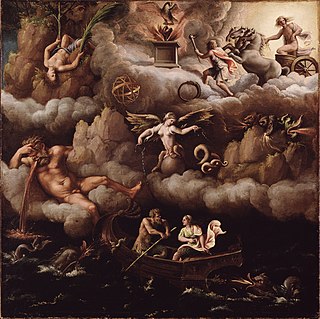
The bunyip is a creature from the aboriginal mythology of southeastern Australia, said to lurk in swamps, billabongs, creeks, riverbeds, and waterholes.

Cryptozoology is a pseudoscience and subculture that searches for and studies unknown, legendary, or extinct animals whose present existence is disputed or unsubstantiated, particularly those popular in folklore, such as Bigfoot, the Loch Ness Monster, Yeti, the chupacabra, the Jersey Devil, or the Mokele-mbembe. Cryptozoologists refer to these entities as cryptids, a term coined by the subculture. Because it does not follow the scientific method, cryptozoology is considered a pseudoscience by mainstream science: it is neither a branch of zoology nor of folklore studies. It was originally founded in the 1950s by zoologists Bernard Heuvelmans and Ivan T. Sanderson.

A dragon is a magical legendary creature that appears in the folklore of multiple cultures worldwide. Beliefs about dragons vary considerably through regions, but dragons in Western cultures since the High Middle Ages have often been depicted as winged, horned, and capable of breathing fire. Dragons in eastern cultures are usually depicted as wingless, four-legged, serpentine creatures with above-average intelligence. Commonalities between dragons' traits are often a hybridization of feline, reptilian, mammalian, and avian features. Some scholars believe large extinct or migrating crocodiles bear the closest resemblance, especially when encountered in forested or swampy areas, and are most likely the template of modern Asian dragon imagery.

In several Bantu mythologies, mokele-mbembe is a mythical water-dwelling entity that is believed to exist in the Congo River Basin. Variously described as a living creature or a spirit, mokele-mbembe's descriptions vary widely based on conflicting purported eyewitness reports, but it is often described as a large quadrupedal herbivore with smooth skin, a long neck, and a single tooth or horn, much like the extinct species sauropods.

A monster is a type of fictional creature found in horror, fantasy, science fiction, folklore, mythology and religion. Monsters are very often depicted as dangerous and aggressive, with a strange or grotesque appearance that causes terror and fear, often in humans. Monsters usually resemble bizarre, deformed, otherworldly and/or mutated animals or entirely unique creatures of varying sizes, but may also take a human form, such as mutants, ghosts, spirits, zombies, or cannibals, among other things. They may or may not have supernatural powers, but are usually capable of killing or causing some form of destruction, threatening the social or moral order of the human world in the process.

The hippogriff or hippogryph, is a legendary creature with the front half of an eagle and the hind half of a horse.

Expedition to the Barrier Peaks is a 1980 adventure module for the Advanced Dungeons & Dragons role-playing game written by Gary Gygax. While Dungeons & Dragons (D&D) is typically a fantasy game, the adventure includes elements of science fiction, and thus belongs to the science fantasy genre. It takes place on a downed spaceship; the ship's crew has died of an unspecified disease, but functioning robots and strange creatures still inhabit the ship. The player characters fight monsters and robots, and gather the futuristic weapons and colored access cards that are necessary for advancing the story.

A Jenny Haniver is the carcass of a ray or a skate that has been modified by hand then dried, resulting in a mummified specimen intended to resemble a fanciful fictional creature, such as a demon or dragon. This practice dates back to the 16th century when these specimens were often sold as curiosities to sailors and collectors.

A hellhound is a mythological hound that embodies a guardian or a servant of hell, the devil, or the underworld. Hellhounds occur in mythologies around the world, with the best-known examples being Cerberus from Greek mythology, Garmr from Norse mythology, the black dogs of English folklore, and the fairy hounds of Celtic mythology. Physical characteristics vary, but they are commonly black, anomalously overgrown, supernaturally strong, and often have red eyes or are accompanied by flames.

Richard Freeman is a cryptozoologist, author, zoological journalist, and WebTV Presenter. He is also the zoological director of the Centre for Fortean Zoology (CFZ), and co-edits both the journal, Animals & Men and several editions of the annual CFZ Yearbook. Freeman has written, co-written, or edited a number of books, and has contributed widely to both Fortean and zoological magazines, as well as other newspapers and periodicals, including Fortean Times and Paranormal Magazine.
Chimera, originally found in Greek mythology, is a monstrous fire-breathing creature composed of the parts of multiple animals. The term, and often the general concept, has since been adopted by various works of popular culture, and chimeras of differing description can be found in contemporary works of fantasy and science fiction.
The Honey Island Swamp Monster, also known as the Cajun Sasquatch and in Cajun French: La Bête Noire, is an ape-like humanoid cryptid creature, similar to descriptions of Bigfoot, purported to inhabit the Honey Island Swamp in St. Tammany Parish, Louisiana. It has become a part of Louisiana folklore, with many swamp tour companies in the area capitalizing on its alleged existence, which is considered unlikely by scientists.

The Gill-man—commonly called the Creature—is the main antagonist of the 1954 black-and-white science fiction film Creature from the Black Lagoon and its two sequels Revenge of the Creature (1955) and The Creature Walks Among Us (1956).

A legendary creature is a type of fantasy entity, typically a hybrid, that has not been proven and that is described in folklore, but may be featured in historical accounts before modernity.

West African mythology is the body of myths of the people of West Africa. It consists of tales of various deities, beings, legendary creatures, heroes and folktales from various ethnic groups. Some of these myths traveled across the Atlantic during the period of the Trans-Atlantic slave trade to become part of Caribbean, African-American and Brazilian mythology.
Reptilian humanoids, or anthropomorphic reptiles, are fictional creatures that appear in folklore, fiction, and conspiracy theories.

Skin of the Sea is a 2021 young adult fantasy novel by Nigerian Welsh writer Natasha Bowen. Bowen's debut novel follows Simi, a mami wata who travels across sea and land in search of the Supreme Creator after breaking a law that threatens the existence of all mami wata.














